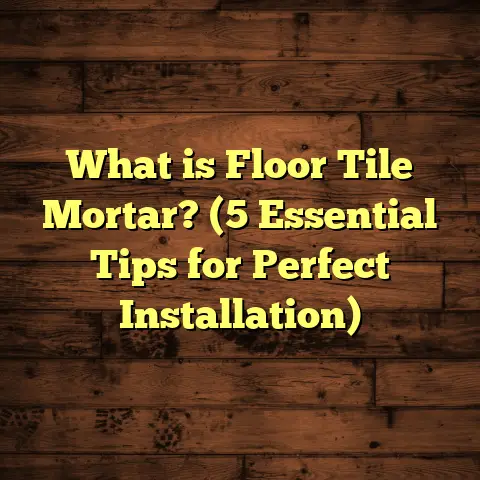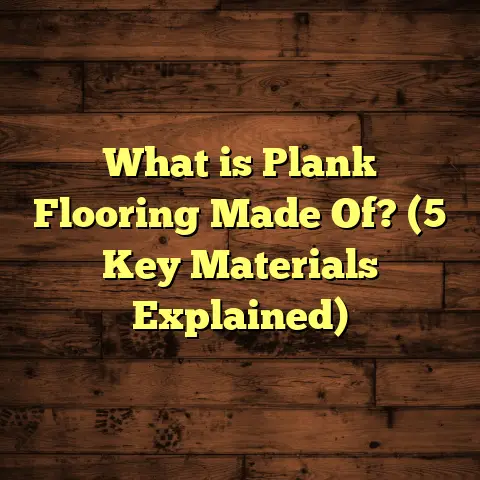What is Sheet Flooring? (5 Benefits for Home Renovation)
Did you know that sheet flooring has been around for over a century but still flies under the radar for many homeowners? When I first got into flooring, I thought hardwood and tiles were the only real options. But the more I worked with sheet flooring, the more I realized how versatile, practical, and cost-effective it really is—and today, I want to share everything I’ve learned with you.
What Is Sheet Flooring?
Let’s start simple. Sheet flooring is a type of flooring material that comes in large continuous rolls. Unlike tiles or planks that you piece together, sheet flooring is unrolled and cut to fit the exact dimensions of the room. This makes for a smooth, seamless surface with very few joints or seams.
Most commonly, sheet flooring is made from flexible materials like vinyl, linoleum, or rubber. Vinyl is by far the most popular today because it’s affordable, durable, and comes in a massive range of designs—from wood grain to stone patterns to bold colors and graphics.
Linoleum is an older material made from natural ingredients like linseed oil and cork dust. It’s eco-friendly and has a matte finish but is less flexible than vinyl.
Rubber sheet flooring is usually found in gyms or playrooms because it absorbs impact well and offers excellent slip resistance.
What Makes Sheet Flooring Different?
The defining factor is its continuous format. That means fewer seams = fewer places for water or dirt to sneak in. This makes it ideal for moisture-prone areas like bathrooms or kitchens.
Sheet flooring can be installed over many subfloors such as concrete, plywood, or even existing floors if they’re smooth and level.
Another plus is that it’s relatively thin—usually around 2 to 5 millimeters—so you don’t have to worry about door clearances or uneven transitions between rooms.
Where and How Sheet Flooring Gets Used
Over the years I’ve worked on countless projects featuring sheet flooring. Its flexibility makes it a top choice for rooms where spills or moisture are expected.
Bathrooms
One of the best uses of sheet flooring is in bathrooms. The seamless nature means water doesn’t pool in grout lines like tile floors. It also feels softer underfoot than ceramic tiles.
I remember installing sheet vinyl in a bathroom remodel where the previous tile had cracked repeatedly due to shifting subfloor issues. The vinyl accommodated slight movements without damage and gave the room a fresh new look.
Kitchens
Kitchens are another hot spot. Between dropped knives, spills, and heavy foot traffic, you need floors that hold up. Sheet vinyl’s resistance to moisture and stains makes cleanup easy.
I had a client who loved cooking but hated cleaning up after. Switching from hardwood (which warped due to water exposure) to a high-end vinyl sheet solved those problems while giving a modern appearance with a faux hardwood design.
Laundry Rooms & Basements
Laundry areas are prone to leaks and humidity. Sheet flooring handles these conditions better than carpet or hardwood. Same goes for basements where moisture is common.
A family I worked with had frequent flooding issues in their basement. After installing rubber sheet flooring with a thick wear layer, they reported feeling confident about their floors surviving minor water events without damage.
Commercial Spaces
Beyond residential use, sheet flooring shows up in schools, hospitals, offices, and retail stores due to its durability and ease of maintenance.
Installation: What You Need to Know
Here’s where many people get nervous: installing sheet flooring might seem intimidating because of those big rolls and precise cutting required.
Preparing the Subfloor
Before laying anything down, you have to make sure the subfloor is clean, flat, dry, and free from imperfections. Even small bumps can telegraph through the thin material.
From experience, I always recommend patching holes with floor patch compound and sanding down rough spots. Moisture testing the subfloor is critical—especially on concrete—to avoid mold or adhesive failure later on.
Handling the Material
Sheet flooring rolls can be bulky—some weigh over 50 pounds for larger widths—so you’ll want at least two people for handling. The material needs to acclimate in your space for 24-48 hours before installation to prevent shrinkage or expansion after installation.
Cutting & Fitting
Precision is key here. I use sharp utility knives and straight edges to cut the material exactly to room dimensions plus any necessary expansion gaps.
Corners and irregular shapes require careful trimming and sometimes heat welding of seams for waterproof integrity.
Adhesive Application
There are two main installation methods: full spread adhesive and loose lay.
- Full Spread Adhesive: You spread adhesive evenly on the subfloor then roll out the sheet flooring on top.
- Loose Lay: The sheet is held in place by its weight and friction or double-sided tape, suitable for smaller rooms or rentals.
I prefer full spread adhesive for permanent installations because it prevents shifting and bubbles over time.
Sealing Edges & Seams
To maximize water resistance, edges should be sealed using heat welding or specialized seam sealers when sheets meet in large rooms.
DIY vs Professional Installation
If your space is simple—a small rectangular room with straight walls—you might pull off DIY installation with patience and the right tools.
But for complex rooms involving multiple seams or curves, hiring a pro saves stress and ensures a long-lasting finish.
I often tell friends that while vinyl sheets seem easy on paper, the real skill shows in flawless cuts and invisible seams—things you only develop with experience.
Maintaining Sheet Flooring: Tips That Work
One of my favorite things about sheet flooring is how low maintenance it is compared to hardwood or tile.
Routine Cleaning
Sweeping or vacuuming regularly prevents grit buildup that can scratch surfaces over time. For sticky spots or stains, damp mopping with mild detergent works wonders.
Avoid harsh chemicals or abrasive cleaners—they can damage the wear layer or dull finishes.
Dealing With Scratches & Scuffs
Though durable, vinyl sheets can get minor scratches from furniture legs or pet nails. Using felt pads under furniture legs prevents damage.
For small scratches, some brands offer repair kits with compounds that fill in marks invisibly. For larger damage areas, replacing entire sections might be necessary but that’s rare with proper care.
Long-Term Care
Avoid dragging heavy objects across floors. If moving appliances during renovations or cleaning, use sliders designed for vinyl sheets.
Also keep an eye on seams for lifting—this could signal adhesive failure or moisture issues needing attention.
Five Benefits of Sheet Flooring for Home Renovation
Let me break down five reasons why sheet flooring often beats other options when renovating your home:
1. Affordability Without Losing Style
Cost plays a big role in renovations. Most vinyl sheet flooring costs between $2-$5 per square foot including materials and installation—much less than hardwood ($8-$15) or premium tile ($7-$20).
Despite this price difference, modern sheet flooring offers thousands of design options from realistic wood grains to marble looks at a fraction of the price. So you don’t have to sacrifice style for budget.
2. Water Resistance Protects Your Floors—and Sanity
Water damage causes billions in home repair annually. Because sheet flooring is one continuous surface, it stops moisture from seeping into cracks as tiles or hardwood might allow.
I’ve seen families avoid costly damage after spills or minor floods simply because their sheet vinyl held up perfectly.
3. Speedy Installation Cuts Renovation Time
Sheet flooring installation usually takes 1-3 days max depending on room size—much faster than tile which requires grout drying time or hardwood needing acclimation plus finishing.
This speed means less disruption at home and faster project completion—a huge plus if you’re juggling life alongside renovations.
4. Durability for Busy Households
High-quality sheet flooring comes with wear layers designed to resist scratches, stains, and dents from daily foot traffic, pets, or kids playing indoors.
For example, commercial-grade vinyl used in offices can withstand thousands of people walking over it weekly without visible wear—even after years.
5. Easy Cleaning Keeps Your Floors Looking Fresh Longer
Since there are no grout lines or joints where dirt hides like tile floors have, cleaning is simple. A quick sweep and mop routine keeps floors looking new longer without special products or labor-intensive upkeep required by carpet or hardwood finishes.
Sharing Personal Stories & Insights
When I first installed sheet vinyl in my own kitchen about seven years ago, I didn’t expect much since I favored hardwood floors professionally. But after living with it daily, I was impressed by how comfortable it felt underfoot and how easy it was to clean up spills—especially coffee stains from my morning rush!
A client once told me she loved her new bathroom floor so much because it never felt cold like tile does in winter mornings—something she appreciated living in a colder climate state.
Another time I worked on a rental property where tenants often caused water damage on hardwood floors before switching to waterproof sheet vinyl saved future headaches and repair costs for the landlord.
Data Points & Industry Trends on Sheet Flooring
According to recent data from the Floor Covering Industry Association:
- Vinyl accounted for nearly 30% of all residential floor coverings installed in 2023.
- The average lifespan of high-quality vinyl sheet flooring ranges from 15-20 years.
- Installation times are typically 30-50% faster than tile or hardwood.
- Maintenance costs over 10 years can be 40% lower due to ease of cleaning and durability.
Environmental awareness has also spurred interest in linoleum—a natural alternative—with sales growth of around 5% annually as homeowners seek sustainable options.
Case Study: Historic Home Renovation with Linoleum Sheet Flooring
I once helped restore a 1920s craftsman bungalow where hardwood floors were too damaged to save but the owners didn’t want modern-looking vinyl sheets ruining the vintage vibe.
We chose linoleum sheets with classic geometric patterns authentic to the era but benefiting from modern durability improvements.
The installation went smoothly despite odd room shapes thanks to flexible sheet format fitting complex layouts better than tiles would have allowed.
Years later, the homeowners still rave about how well their floors have held up through family gatherings, pets running around, and wet weather seasons without losing charm or function.
Cost Estimation Made Easy Using Tools Like FloorTally
Estimating costs accurately can be tricky when planning any flooring project. That’s where FloorTally comes in handy for me—it helps calculate not only material quantities but also labor costs based on local rates, which vary widely depending on where you live.
For example: On a recent project with a 400 sq ft kitchen + bathroom combo using vinyl sheet flooring:
- FloorTally estimated materials (rolls + adhesive) at around $1,200.
- Labor costs came out near $800 based on regional averages.
- It factored in a waste allowance of 10% for trimming and errors.
These detailed estimates saved me from ordering too little material (which would cause delays) or too much (which wastes budget).
Using tools like this lets me give clients realistic quotes upfront so we avoid surprises during installation—making everyone’s life easier!
Comparing Sheet Flooring to Other Popular Options
It’s natural to wonder how sheet flooring stacks up against hardwood planks or ceramic tiles since those are often considered premium choices.
| Factor | Sheet Flooring | Hardwood | Ceramic Tile |
|---|---|---|---|
| Cost per sq ft | $2-$5 | $8-$15 | $7-$20 |
| Installation Time | 1-3 days | Several days + finishing | Several days + grout curing |
| Water Resistance | Excellent | Poor (damages easily) | Excellent |
| Maintenance | Easy (sweep + mop) | Moderate (regular polishing) | Moderate (grout cleaning) |
| Durability | High (scratches resistant) | High but dents/scuffs possible | Very high (hard breakage risk) |
| Comfort | Softer underfoot | Hard but warm | Hard + cold |
| Design Variety | Huge range | Natural wood variations | Wide tile designs |
If budget constraints are tight but durability and water resistance matter most—sheet flooring wins hands down.
Frequently Asked Questions About Sheet Flooring
Q: Can sheet vinyl be installed over existing floors?
A: Yes! If existing floors are smooth, clean, and level (like old vinyl or concrete), you can install directly over them without removing first.
Q: How long does sheet flooring last?
A: With good maintenance, high-quality sheets last between 15-20 years depending on wear levels.
Q: Is sheet flooring eco-friendly?
A: Vinyl isn’t great environmentally but linoleum sheets are made from natural materials making them more sustainable choices.
Q: Can I install sheet flooring myself?
A: Possible on small rooms with straight walls but professional installation recommended for best results especially on complex layouts.
Q: How do I repair damage?
A: Small scratches can be filled with repair kits; larger damage might require patch replacement by cutting out affected sections carefully.
Sheet flooring has come a long way since its early days as a basic utility floor covering. With advances in design options and durability, it’s now a strong contender for any home renovation project needing affordable style paired with practical performance.
I’ve seen firsthand how choosing sheet flooring solves common headaches around moisture damage, maintenance hassle, and long install times—all while opening up creative design possibilities without breaking budgets.
If you want help figuring out whether sheet flooring fits your next project or need tips on installation products and prep steps, just ask! I’m happy to share what I’ve learned after years working hands-on with this versatile material.
Have you ever given sheet flooring a shot? If not yet—maybe now’s the perfect time to reconsider this often underrated option!





